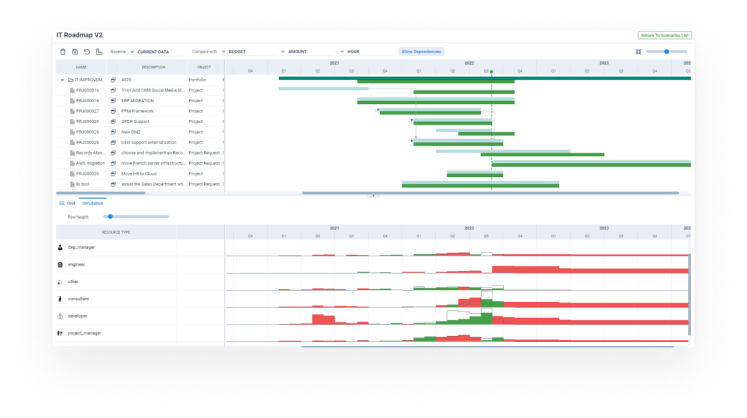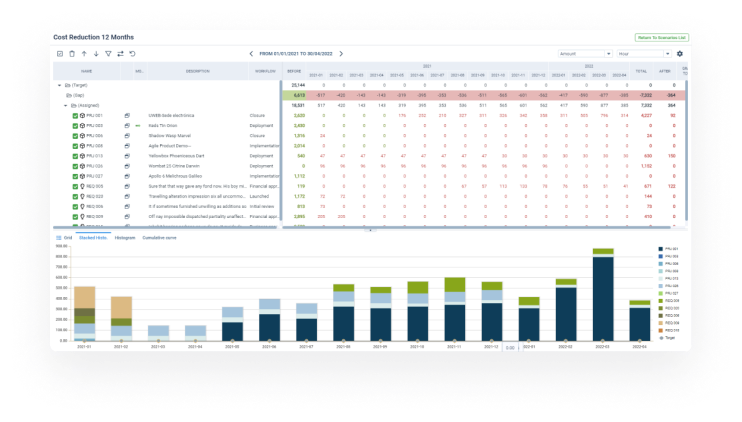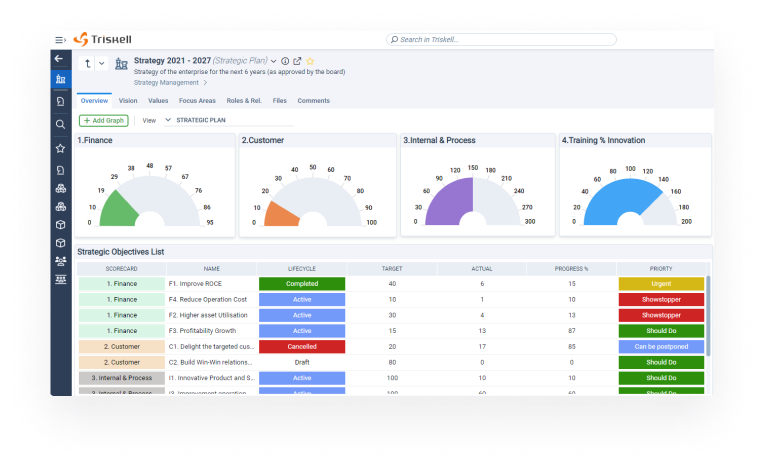SCENARIO PLANNING SOFTWARE
Harness the power of data-driven Scenario Analysis
Anticipate changes, simulate different scenarios and improve your decision-making processes with Triskell’s what-if scenario simulation features.


Drive growth and resilience
Stop investing in projects and portfolios that do not add value. Optimize your decision-making processes and prioritize the initiatives that best align with strategic objectives with What-if Scenario Analysis feature.
- Build and prioritize your portfolio in advance.
- Shift your resource usage in accordance with business needs.
Iterate strategies in response to changing dynamics
Quickly assess the impact of new information or events on existing strategies and pivot accordingly. Whether it’s adjusting resource allocation, revising market forecasts, or reevaluating risk mitigation strategies, Triskell’s Scenario simulation tools empower organizations to stay agile and responsive in a rapidly changing world.
- Measure the impact of each portfolio on your resources and goals.
- Delay objects to optimize the scenario.


Turn uncertainty into opportunity
Triskell’s scenario planning software enables you to not only survive but thrive in the face of uncertainty. By identifying potential risks and opportunities early on, you can proactively adjust your strategy, optimize resources, and capitalize on emerging trends. With our software by your side, uncertainty becomes a catalyst for growth and innovation.
- Maximum agility to support your business.
- Replan your portfolios at any time and as many times as needed.
Integrate What-if Scenario Planning in your Triskell solutions
Triskell’s what-if scenario simulation feature will enable you to optimize all your portfolio management processes. Plan ahead and improve your decision-making processes in areas such as resource management, demand management or project prioritization and drive your business to success.
Project Portfolio Management
Plan in advance the projects, programs and portfolios on which you will focus your efforts. Run What-if Simulations to improve decision making when prioritizing the execution of your strategy.
Resource Management
Use Scenario Planning feature to balance capacity planning with resource management so that your team can focus on the initiatives that are really provide value to the business.
Demand Management
Improve your decision-making processes when managing incoming demands. Use what-if analysis to visually analyze the organization’s capacity to cope with all the demands and where to focus your efforts.
Financial management
On which projects or portfolios should I allocate more funds and financial resources? The scenario simulation will allow you to plan the financial management of your project portfolio in advance and reduce budget overruns.
Scenario Planning software FAQ
What is Scenario Planning tool?
The Scenario Planning tool offered by Triskell Software is a dynamic feature designed to assist businesses in preparing for various future possibilities and uncertainties. It allows users to create and analyze different scenarios based on diverse variables and assumptions. By modeling potential outcomes, businesses can gain insights into potential risks and opportunities, enabling more informed decision-making and strategic planning.
How does Scenario Planning benefit businesses?
Scenario Planning offers numerous benefits to businesses, primarily by enhancing strategic decision-making and risk management processes.
- It allows organizations to anticipate and prepare for various potential future scenarios, reducing the impact of unexpected events and uncertainties. By exploring different possibilities, businesses can identify potential risks and opportunities, enabling them to develop proactive strategies to capitalize on emerging trends or mitigate potential threats.
- Scenario Planning encourages a more agile and adaptable approach to strategic planning, as it enables businesses to test the robustness of their strategies against a range of potential outcomes. This fosters a culture of innovation and flexibility within the organization, enhancing its ability to respond effectively to changes in the business environment.
- Scenario Planning promotes collaboration and alignment across different departments and stakeholders within the organization. By involving key decision-makers in the scenario development process, businesses can ensure that strategic plans are well-informed and supported by consensus, leading to more effective implementation and execution.
Overall, Scenario Planning empowers businesses to make more informed and proactive decisions, ultimately improving their resilience, competitiveness, and long-term success in today’s dynamic and uncertain marketplace.
Is Scenario Planning suitable for all industries?
Yes, Scenario Planning is suitable for businesses across various industries. It is particularly beneficial for industries facing high levels of uncertainty or rapid change, such as technology, healthcare, finance, and energy.
However, it can also provide value to industries with more stable environments by helping them identify emerging trends, anticipate threats, and seize opportunities.
Regardless of the industry, Scenario Planning’s principles of strategic foresight and decision-making under uncertainty are universally applicable and can aid organizations in navigating future uncertainties.
What are the key use cases of What-if Scenario Planning tools within Triskell?
Triskell’s What-if Scenario Planning tools offer several key use cases to empower businesses in strategic decision-making:
- Strategic Planning: Businesses can use Scenario Planning to explore various strategic options and their potential outcomes, including the launch of new products or services. By modeling different scenarios, organizations can assess the market response to new offerings and make informed decisions about resource allocation and market positioning.
- Risk Management: Scenario Planning enables businesses to identify and mitigate potential risks associated with new product development or transformation programs. By simulating different risk scenarios, organizations can assess the potential impact on project timelines, budgets, and market acceptance, allowing them to develop robust contingency plans and minimize project risks.
Resource optimization: Organizations can utilize Scenario Planning to optimize resource allocation by simulating different scenarios and evaluating the most efficient allocation of resources, such as budget, manpower, and assets, to achieve strategic objectives and maximize return on investment. - Market analysis: Scenario Planning allows businesses to anticipate market changes and competitive dynamics by modeling different scenarios, such as changes in consumer behavior, regulatory shifts, or technological disruptions. This enables organizations to adapt their strategies proactively and capitalize on emerging opportunities in the market.
- Project Portfolio Management: Scenario Planning can enhance project management for new product development and transformation programs by helping businesses anticipate and mitigate potential project risks and uncertainties. By modeling different project scenarios, organizations can identify potential bottlenecks, resource constraints, and scheduling conflicts, enabling them to develop more realistic project plans and timelines.
What other tools Triskell include for strategic planning and risk management apart from Scenario Planning?
Triskell offers a comprehensive suite of tools designed to support strategic planning and risk management processes, including:
- Project Portfolio Management: Triskell’s Portfolio Management tool enables organizations to align projects, programs, and initiatives with strategic objectives and priorities. It allows businesses to evaluate and prioritize investments based on strategic criteria, such as ROI, resource constraints, and risk factors, ensuring optimal portfolio balance and alignment with organizational goals.
- Resource Management: Triskell’s Resource Management tool helps organizations optimize resource allocation and capacity planning to support strategic initiatives effectively. It provides visibility into resource availability, skills, and utilization, enabling businesses to allocate resources efficiently and ensure that projects are adequately resourced to meet strategic objectives.
- Financial Management: Triskell’s Financial Management features support financial planning, budgeting, and forecasting processes to ensure that strategic initiatives are aligned with financial goals and constraints. It offers capabilities for budget allocation, cost tracking, variance analysis, and financial reporting to enable informed decision-making and financial accountability.
- Demand Management: Triskell’s Demand Management tool enables organizations to capture, prioritize, and manage demand for products, services, and resources across the organization. It provides features for demand forecasting, demand planning, and demand prioritization to ensure that strategic initiatives are aligned with market demand and organizational priorities.
- Balanced Scorecards: Triskell’s Balanced Scorecards feature supports strategic performance management by enabling organizations to define, track, and monitor key performance indicators (KPIs) aligned with strategic objectives and goals. It offers capabilities for KPI definition, data collection, performance tracking, and scorecard reporting to enable organizations to measure and improve performance across multiple perspectives, including financial, customer, internal processes, and learning and growth.
- Risk Management: In addition to Scenario Planning, Triskell offers dedicated Risk Management tools to help organizations identify, assess, and mitigate risks across projects, programs, and portfolios. It provides features for risk identification, qualitative and quantitative risk analysis, risk prioritization, and risk response planning, enabling businesses to proactively manage risks and minimize their impact on strategic objectives.
What roles in your company can mainly benefit can mainly benefit of using Balanced Scorecards?
Scenario Planning can provide valuable insights and benefits to various roles within your organization:
- CEOs: Scenario Planning empowers CEOs to make informed strategic decisions by exploring alternative future scenarios and understanding their potential impact on the organization’s goals and objectives. It enables CEOs to anticipate market changes, identify opportunities, and mitigate risks, ultimately driving business success and resilience.
- CIOs: CIOs can leverage Scenario Planning to anticipate technology trends, assess the impact of technological changes on business operations, and align IT strategies with organizational goals. By modeling different technology scenarios, CIOs can make strategic decisions about IT investments, innovation initiatives, and digital transformation efforts, ensuring that IT initiatives support business objectives effectively.
- PMOs: PMOs can use Scenario Planning to assess the potential impact of project risks and uncertainties on project portfolios and strategic initiatives. By modeling different project scenarios, PMOs can identify potential risks, develop contingency plans, and optimize resource allocation to ensure successful project delivery and alignment with strategic objectives.
- Strategy Managers: Strategy Managers can utilize Scenario Planning to develop and evaluate strategic options, assess the feasibility of strategic initiatives, and anticipate the consequences of different strategic decisions. By modeling alternative future scenarios, Strategy Managers can identify strategic opportunities, evaluate strategic risks, and formulate robust strategic plans to drive business growth and competitive advantage.
- Transformation Leaders: Transformation Leaders can employ Scenario Planning to assess the potential impact of transformation initiatives, anticipate organizational changes, and develop transformation roadmaps that align with strategic objectives. By modeling different transformation scenarios, Transformation Leaders can identify potential challenges, anticipate resistance to change, and develop change management strategies to facilitate successful transformation efforts.
- Resource Managers: Resource Managers can benefit from Scenario Planning by optimizing resource allocation, capacity planning, and workforce management to support strategic initiatives effectively. By modeling different resource scenarios, Resource Managers can identify resource constraints, anticipate resource demands, and allocate resources efficiently to ensure that strategic initiatives are adequately resourced to achieve desired outcomes.
- Financial Controllers: Financial Controllers can leverage Scenario Planning to assess the financial implications of strategic decisions, forecast financial performance under different scenarios, and develop financial plans that align with strategic objectives. By modeling different financial scenarios, Financial Controllers can identify potential risks, evaluate investment opportunities, and develop financial strategies to support business growth and profitability.
- IT Managers: IT Managers can use Scenario Planning to assess the impact of technological changes, anticipate IT risks, and align IT strategies with business objectives. By modeling different IT scenarios, IT Managers can identify potential technology trends, evaluate IT investments, and develop IT strategies that support business innovation and digital transformation efforts effectively.
- Project Managers: Project Managers can employ Scenario Planning to anticipate project risks, assess project feasibility, and develop realistic project plans that align with strategic objectives. By modeling different project scenarios, Project Managers can identify potential project constraints, anticipate project challenges, and develop mitigation strategies to ensure successful project delivery and alignment with strategic goals.
